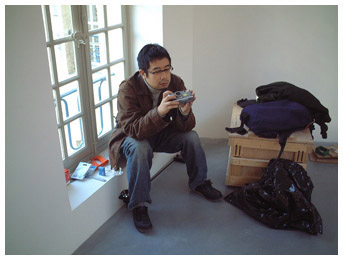


 |


launch interview with Tsuyoshi Ozawa
Tsuyoshi Ozawa is an artist with a knack for combining the real and the virtual and for turning lighthearted critiques into real alternatives. His Museum of Soy Sauce Art (1998-2000), a parodic look at Japanese art history, features many familiar Japanese masterworks re-created in soy sauce. Displayed with texts tracing the venerable, but entirely imaginary, history of soy sauce art, the installation drew the attention of a director of a soy sauce company. At first regretting his ignorance of soy sauce painting, the director laughed "with indescribable satisfaction" when he found out that the entire project was imaginary and ended up funding a franchise of the original temporary museum. Ozawa's Nasubi Gallery, consisting of milk-box-sized portable exhibition halls, was originally conceived as a critique of the Japanese system of "pay to show" rental galleries but also existed as a real alternative to those galleries, profiling both famous and unknown artists. Such public artworks are deeply influenced by the Neo Dadism Organizers, an art group active in Tokyo in the 1960s, and by Fluxus. Quietly and beautifully transgressive, his works are interventions in a mundane and sometimes oppressive world.
Like several artists in How Latitudes Become Forms, Ozawa is interested in artistic practice as a part of everyday life. His ongoing Jizoing project, for which he takes daily photos of a jizo (a familiar Japanese bodhisattva, one of the many incarnations of Buddha), is both an artwork and a daily meditation. Taking the pictures in areas of political turmoil, he noted that the light at dusk is the same all over the world. This led to the Twilight Jizoing Series, photographs taken at twilight every day and printed in the "peaceful and healing" color of blue. Both vernacular and conceptual, Ozawa's work seeks always to communicate. For his Sodan (Consultation) works, he first created paintings in consultation with successive advisors on the street and then created The University of Sodan Art, an art school that taught Sodan painting as well as a course on overcoming one's fears, and mounted a number of performances and exhibitions.
Ozawa has exhibited in Asia and abroad. Recent solo exhibition venues include Ota Fine Arts, Tokyo, Japan (2000), and the Asian Fine Arts Factory, Berlin, Germany (1999). In addition, he was featured in the 2002 Gwangju Biennale, South Korea; IKIRO/Be Alive: Contemporary Art from Japan 1980 to the Present (2001) at the Kröller-Müller Museum in Otterlo, The Netherlands; Public Offerings (2001), organized by the Museum of Contemporary Art, Los Angeles, California; Cities on the Move (1999), Vienna, Austria; and the First Fukuoka Asian Art Triennale, Japan (1999).
--Aimee Chang











